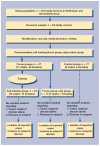Increased awareness of intimate partner abuse after training: a randomised controlled trial
- PMID: 16611512
- PMCID: PMC1832231
Increased awareness of intimate partner abuse after training: a randomised controlled trial
Abstract
Background: Intimate partner abuse is very common among female patients in family practice. In general, doctors overlook the possibility of partner abuse.
Aim: To investigate whether awareness of intimate partner abuse, as well as active questioning, increase after attending focus group and training, or focus group only.
Design of study: Randomised controlled trial in a stratified sample.
Setting: Family practices in Rotterdam and surrounding areas.
Method: A full-training group (n = 23), a group attending focus group discussions alone (n = 14), and a control group (n = 17) were formed. Data were collected with incident reporting of every female patient (aged >18 years) that was suspected of, or presented, partner abuse during a period of 6 months. The primary outcome measure was the number of reported patients; the secondary outcome measure was the number of patients with whom the GP had non-obvious reasons to suspect/discuss abuse.
Results: Comparison of the full-training group (n = 87 patients) versus the control group (n = 14 patients) resulted in a rate ratio of 4.54 (95% confidence interval [CI] = 2.55 to 8.09, P <0.001); the focus group only group (n = 30 cases) versus control group: rate ratio of 2.2 (95% CI = 1.14 to 4.26, P = 0.019); full-training versus the focus group only group: rate ratio of 2.19 (95% CI = 1.36 to 3.52, P = 0.001). Comparison of the fulltraining group with the untrained groups for awareness of partner abuse in case of non-obvious signs resulted in: odds ratio 5.92 (95% CI = 2.25 to 15.62, P <0.01) all corrected for sex, district, practice setting, working part/full-time, experience, and age of the doctor.
Conclusions: Training was the most significant determinant to improve awareness and identification of intimate partner abuse. Active questioning increased, especially where there were non-obvious signs. The focus group on its own doubled the awareness of partner abuse.
Figures
Comment in
-
Responding to intimate partner violence: what role for general practice?Br J Gen Pract. 2006 Apr;56(525):243-4. Br J Gen Pract. 2006. PMID: 16611508 Free PMC article. No abstract available.
References
-
- Watts C, Zimmerman C. Violence against women: global scope and magnitude. Lancet. 2002;359:1232–1237. - PubMed
-
- Hegarty KL, Bush R. Prevalence and associations of partner abuse in women attending general practice: a cross-sectional survey. Aust N Z J Public Health. 2002;26(5):437–442. - PubMed
-
- Cohen S, De Vos E, Newberger E. Barriers to physician identification and treatment of family violence: lessons from five communities. Acad Med. 1997;72(1 Suppl):S19–25. - PubMed
Publication types
MeSH terms
LinkOut - more resources
Full Text Sources
Research Materials



